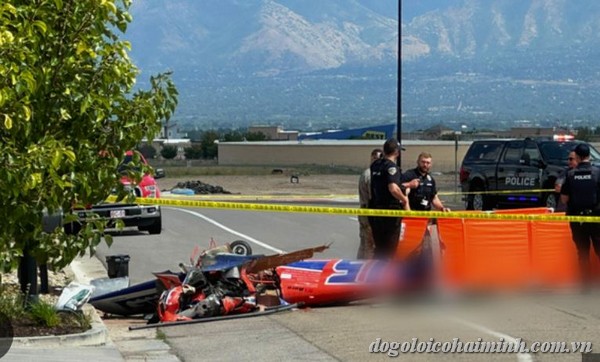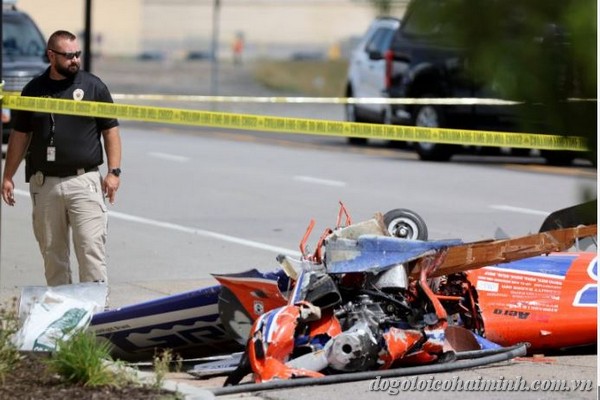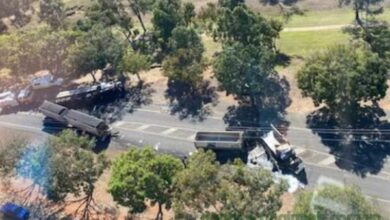Airplane Crash West Jordan: Causes And Consequences Of The Accident

Welcome to dogoloicohaiminh.com.vn, your definitive source for insights into the “Airplane Crash West Jordan: Causes and Consequences of the Accident.” Delve into a comprehensive analysis of the incident, uncovering the factors that led to this unfortunate event and understanding the far-reaching effects it has brought about. Our meticulously curated content offers you an in-depth understanding of the incident, its implications, and the lessons we can glean from it to enhance aviation safety. Stay informed as we explore the details and aftermath of the West Jordan airplane crash.

I. Details of airplane crash West Jordan
1. Time and Location of the Incident
The heart-wrenching airplane crash unfolded with tragic consequences near West Jordan, sending shockwaves through the local community and reverberating beyond. The incident took place on a seemingly ordinary day, shortly after 12:30 PM, at the intersection of Copper Hills Parkway and 7800 South. This specific time and location serve as the pivotal backdrop against which the unfolding events and subsequent investigations can be comprehended.
As the sun hung high in the sky, a sudden and unforeseen calamity struck, leaving an indelible mark on the lives of those in the vicinity. The convergence of these coordinates marked the starting point of a series of events that would prompt a thorough examination into the causes of this unfortunate accident.
2. Confirmation of Pilot and Aircraft Information
Creighton King, the pilot at the helm of the ill-fated flight, has been definitively identified through the collective affirmation of his family members and official sources. This confirmation has begun to piece together the human aspect of this tragedy, revealing a glimpse into the life of the individual who found themselves in the midst of this catastrophic event.
Additionally, delving into the intricacies of the aircraft involved is pivotal in unraveling the technical nuances that may have contributed to the crash. Insight into the model, registration, and perhaps any prior maintenance history offers a lens through which to scrutinize potential mechanical factors. Understanding the pilot’s and aircraft’s particulars aids in constructing a comprehensive narrative of the circumstances preceding the accident.
Piecing together the puzzle of these details, such as the time, location, pilot, and aircraft specifics, empowers us to begin unraveling the layers of this tragedy. It’s through these elements that the causes and consequences of the airplane crash near West Jordan come into sharper focus, fostering an essential foundation for deeper analysis and understanding.
II. Causes of the Airplane crash
1. Evidence of Aircraft Contact and Oil Traces on the Ground
Scrutinizing the immediate aftermath of the airplane crash reveals crucial clues that shed light on the circumstances leading to the tragic event. Investigative teams have uncovered evidence of the aircraft’s contact with the terrain, manifesting as debris strewn across the area. Moreover, the presence of oil traces on the ground points to potential mechanical issues or irregularities that warrant thorough analysis. These physical markers offer early insights into what transpired during the final moments of the flight.
2. Eyewitness Accounts and Testimonies
Gathering the accounts of eyewitnesses and individuals who directly observed the crash provides invaluable perspectives on the unfolding events. These firsthand testimonies serve as crucial pieces of the puzzle, helping to reconstruct the sequence of actions that preceded the crash. The collective narratives of those who were present at the time offer diverse viewpoints that complement technical investigations. Understanding their observations and experiences deepens our understanding of the tragedy.
3. Environmental and Weather Factors
The environmental and weather conditions prevailing at the time of the airplane crash constitute significant variables that warrant thorough examination. Fluctuations in wind patterns, visibility, and atmospheric conditions can impact flight operations, potentially creating challenges for pilots. Investigating whether adverse weather conditions played a role is essential in unraveling the complexities of the crash. By scrutinizing these variables, investigators can determine the extent to which environmental factors contributed to the unfortunate outcome.
Exploring these dimensions, from physical evidence to firsthand accounts and environmental considerations, is pivotal in piecing together a comprehensive understanding of the airplane crash’s underlying causes. Each facet provides a unique angle of analysis, collectively contributing to a more complete picture of the events that led to this tragic incident.

III. Victims of the Airplane Crash
1. Pilot’s Background and Experience
Creighton King, the pilot at the heart of this tragic incident, possessed a notable background and wealth of experience in aviation. With a history of participation in significant events like the Reno Air Races, his journey as a skilled aviator was well-documented. Past experiences, including a previous airplane incident near Utah’s lakeside, offered insights into his ability to navigate challenges and emerge unscathed. King’s remarkable journey through the skies adds a personal dimension to the narrative.
2. Impact on the Community and Family
Beyond the technical aspects of the crash, the emotional toll on the community and King’s family is profound. Remembered by friends and acquaintances as a vivacious and kind individual, King’s presence in his community was significant. His contributions extended beyond aviation, with involvement in political and community activities. The tragic accident not only leaves a void in the aviation world but also casts a shadow over the lives of those who knew and admired him.
3. Support and Remembrance
In the wake of this heartbreaking incident, a crowdfunding effort has been launched to support King’s wife and two daughters as they navigate the financial challenges associated with the aftermath. The outpouring of support from the community is a testament to the impact King had on those around him. This campaign reflects the unity and empathy that emerge in times of adversity, ensuring that his legacy endures through the memories of those he touched.
The victims of the airplane crash extend beyond the immediate consequences of the incident, reaching into the lives of those who cherished Creighton King and felt the ripples of his absence. Understanding the broader impact emphasizes the human aspect amidst the technical intricacies surrounding the tragedy.
IV. Aviation Safety Measures
1. Aircraft Inspection and Maintenance Procedures
Ensuring the safety of flights necessitates meticulous aircraft inspection and maintenance protocols. Regular checks and adherence to maintenance schedules are paramount in identifying potential mechanical issues before they escalate into critical problems. Thorough examinations of critical components, systems, and structural integrity play a pivotal role in preventing accidents. The investigation into the airplane crash near West Jordan underscores the importance of rigorous inspection routines in maintaining safe flight operations.
2. Significance of Adhering to Safety Regulations
The aviation industry is governed by a complex web of safety regulations and guidelines aimed at minimizing risks and ensuring the well-being of passengers, crew, and the public. The tragedy serves as a stark reminder of the importance of unwavering adherence to these regulations. Pilots, operators, and stakeholders must recognize the crucial role they play in upholding safety standards. A comprehensive understanding of and compliance with these regulations collectively contribute to creating a safer aviation environment.
The focus on aviation safety measures resonates as a cornerstone for preventing future accidents. By addressing the proactive aspects of aircraft maintenance and embracing stringent safety regulations, the aviation community can mitigate risks and ensure the well-being of all those involved in air travel.
V. Consequences of the Airplane Crash
1. Emotional Impact on the Community
The aftermath of the airplane crash reverberates through the community, leaving a profound emotional impact. Shock and grief permeate the atmosphere as residents grapple with the sudden loss. Vigils, tributes, and expressions of solidarity emerge as the community unites to mourn the victims and support their families. The tragedy serves as a somber reminder of the fragility of life and the importance of coming together in times of adversity.
2. Reevaluation of Safety Protocols
The tragic incident prompts a critical reevaluation of existing safety protocols and procedures. Aviation authorities and stakeholders engage in comprehensive reviews to identify potential gaps in safety measures. Lessons learned from this accident can inform the enhancement of safety training, pilot education, and procedural adjustments to prevent similar incidents in the future. The crash acts as a catalyst for continuous improvement in aviation safety.
3. Impact on Aviation Industry Reputation
Airplane crashes have far-reaching implications, affecting not only the local community but also the reputation of the aviation industry as a whole. Such incidents can lead to public skepticism and erode trust in air travel. To restore confidence, transparent investigations, proactive safety measures, and effective communication are essential. Demonstrating a commitment to learning from accidents and implementing measures to prevent recurrence is paramount in maintaining the industry’s credibility.
The consequences of the airplane crash extend beyond the immediate tragedy, sparking reflection, introspection, and the pursuit of improved safety standards. The aftermath serves as a call to action for communities, regulators, and aviation professionals alike to work collaboratively in minimizing risks and ensuring the highest level of safety in air travel.
VI. Impact on the Community and Families
1. Community’s Emotional State after the Accident
The airplane crash’s repercussions resonate deeply within the community, evoking a spectrum of emotions. The shockwaves of the incident create an atmosphere of sorrow, disbelief, and empathy among the local residents. As the news spreads, solidarity prevails, leading to collective mourning and shared grief. The incident serves as a stark reminder of life’s fragility, prompting the community to rally together in support of those affected.
2. Family and Loved Ones of Pilot Creighton King
Behind the headlines and investigations lie the human faces of those most affected by the tragedy. Creighton King’s family and loved ones bear an immense burden as they grapple with the loss of a cherished family member. His legacy as a talented pilot, inventor, and compassionate community member reverberates through the lives he touched. The enduring love and connection within his family stand as a testament to his profound impact.
The impact on the community and King’s family underscores the far-reaching consequences of the airplane crash. The collective emotional response and personal stories remind us of the interconnectedness of humanity and the importance of extending empathy and support during times of adversity.
VII. Conclusion
1. Summing Up Key Points Addressed in the Article
In reflection, this article has delved into the intricate details surrounding the “Airplane Crash West Jordan: Causes and Consequences of the Accident.” The timeline, location, and confirmation of pilot and aircraft information offered a comprehensive foundation for understanding the incident. We examined the evidence of aircraft contact, oil traces, and eyewitness accounts, shedding light on the immediate aftermath. Moreover, the environmental factors and weather conditions added layers to our understanding of the tragedy’s context.
2. Appreciating the Significance of Elevating Aviation Safety
The insights garnered from this unfortunate event emphasize the critical importance of aviation safety measures. Rigorous aircraft inspection and adherence to safety regulations are cornerstones for preventing such incidents. Recognizing the broader impact on the community and families compels us to prioritize safety, not only for those directly involved but for everyone who trusts in the skies.
As we navigate the complexities of aviation, learning from this incident and fostering continuous improvement within the industry can help minimize risks and ensure safer skies for all. The lessons drawn from this tragedy underscore the collective responsibility to uphold aviation safety and honor the memories of those affected by this unfortunate accident.









